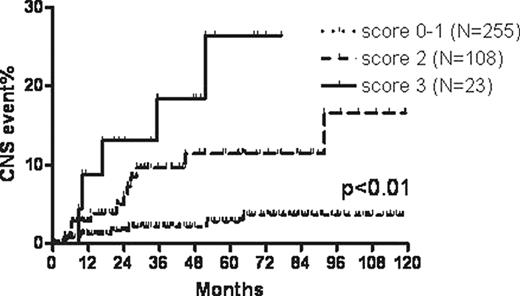Abstract
Abstract 4154
CNS relapse is a challenging complication in patients with DLBCL. Identification of high risk population is therefore critical, in whom prophylactic intrathecal (IT) chemotherapy may play a significant role. To calculate the cumulative incidence of CNS relapse, Kaplan-Meyer method tends to overestimate the incidence because a censored individual by death is still assumed to have a chance to fail from CNS relapse. To overcome this methodological conflict, we evaluated the risk factors for CNS relapse in patients with DLBCL using CRR analysis.
Medical records of patients with DLBCL newly diagnosed and treated with CHOP or R-CHOP at Aichi Cancer Center Hospital between 1995 and 2008 were reviewed. Patients were excluded if they had evidences of CNS involvement at initial diagnosis.
A total of 386 patients who met the criteria for the study were analyzed. The median age of patients was 62 (range 18–95). All patients received CHOP based systemic chemotherapy with (n=203) or without (n=183) rituximab. Prophylactic IT chemotherapy was provided to 6 patients with testicular involvement. At a median follow up duration of 52.9 months, 24 patients experienced CNS relapse. Nine patients presented with brain parenchymal mass, 12 patients presented with leptomeningeal disease, and 3 patients presented with both. The median time from initial diagnosis to CNS relapse was 20.5 months (range 5.3–91.8 months). Five-year cumulative incidence of CNS relapse was 6.7% (95%CI: 4.2–9.8). Five-year cumulative incidence of CNS relapse in patients treated with and without rituximab was 5.9% and 7.3%, respectively (p=0.42). Multivariate analysis for the risk factors of CNS relapse using CRR identified three independent risk factors for CNS relapse; bulky disease (SHR 3.34 [1.45-7.66], p=0.004), lymphocyte count<1.0 ×109/L (SHR 2.38 [1.05-5.39], p=0.017) and extranodal involvement (SHR 2.90 [1.01-8.33], p=0.047). Patients with all three risk factors represented 6% of all patients, in whom the 5-year cumulative incidence of CNS relapse was 26% (Figure 1). When the number of extranodal involvement was taken into account, patients with 3 or more sites of extranodal involvement had extremely high incidence of CNS relapse (28%), all occurring within 18 months after initial diagnosis. These patients may be good candidates for CNS evaluation at initial diagnosis even in the absence of neurological manifestation.
We identified significant risk factors for CNS relapse in patients with DLBCL using CRR. Evaluation for CNS involvement and prophylactic IT chemotherapy should be considered in patients with high risk features.
No relevant conflicts of interest to declare.
Author notes
Asterisk with author names denotes non-ASH members.


This feature is available to Subscribers Only
Sign In or Create an Account Close Modal